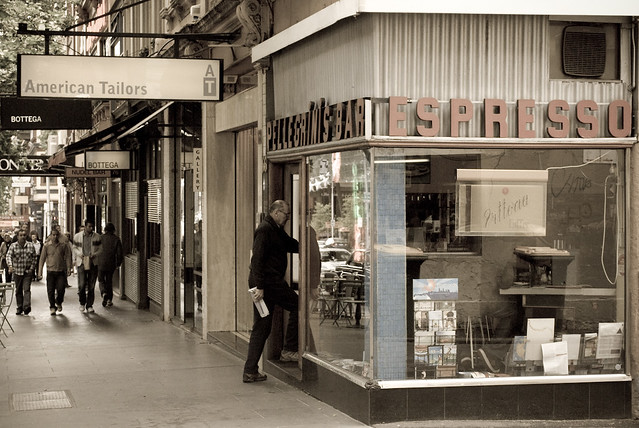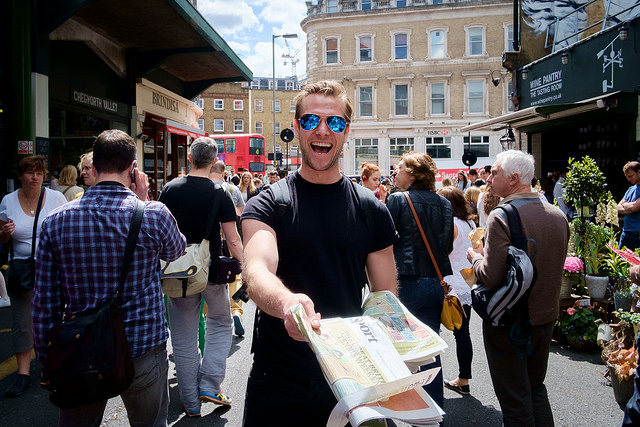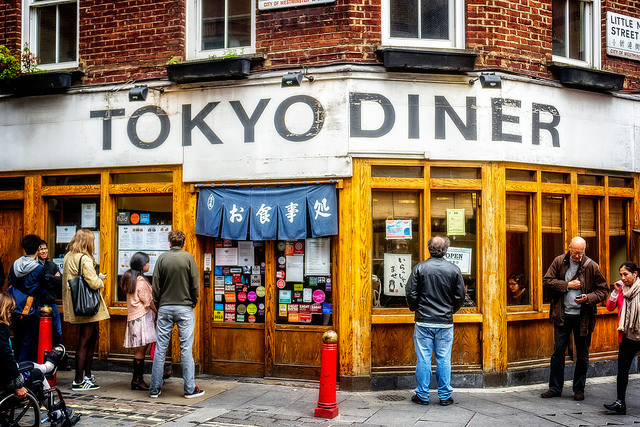Search Results: one of the few
Earning A Competitive Advantage
filed in Marketing, Story Skills

The German restaurant in our neighbourhood closed its doors after a year in operation. The chef’s reputation and inventive menu were not enough to draw sufficient numbers of customers to make it viable.
We knew it was only a matter of time before another owner took over the lease. And sure enough, last weekend we saw a new coffee machine installed and the tables and chairs being delivered.
There are six cafes selling great coffee and a decent brunch within a hundred metres of this one. So, what does the owner believe her competitive advantage will be?
Few new businesses have an unassailable advantage—one that makes them the only choice for a prospective customer. Most don’t make measurably superior products or own proprietary software. They haven’t patented a secret formula, and they don’t necessarily have more resources or talent than the next company.
Successful companies don’t expect to start out ahead of the game on day one. They plan to earn an advantage over time, by knowing who they want to serve, and how—then building on their strengths to tell the story that matches their ideal customer’s worldview.
And when they do, they give their customers a story to tell, compounding their advantage as they go.
Image by Valberg Larusson
Competence AND Character

Our family moved to Melbourne almost five years ago. By some happy accident, we ended up finding the perfect home—an 1850’s terrace, one of the first houses to be built in the city.
The house next door has been empty since we moved in. The elderly couple who raised their family in it had hardly updated it in seventy years. We knew it would be sold one day and the new owners would renovate. We looked forward to seeing the old home restored to its former glory. But we were dreading the day the builders arrived with their jackhammers.
The house sold last winter and the builders arrived a few weeks ago. They are still at the demolition phase, and I have no idea about the quality of their workmanship yet. But we’re more at ease about how the building work next door might affect us—not because it won’t, but because of how the builders are going about it.
It turns out that the builders are wonderful. They do everything they can not to disturb us and reassure us that they will make good on things that affect our property. It’s their character, not their competence that makes them stand out.
Character is what we choose to do.
As individuals and brands, we’re judged by our character, not just our competence.
How does your character differentiate you?
Image by Pictr73
Without You
filed in Story Skills, Storytelling

If I were to ask you to explain your company’s ‘value proposition’ you’d probably hesitate. But if I asked you what your customer would miss if your work didn’t exist, you’d likely have some thoughtful answers about why she needs what you make, serve or sell. Sometimes the language and frames we use stop us expressing ourselves clearly.
One way to begin describing the value you create is to talk about what can’t happen without you.
Without us fewer people can/are/feel/have/do/become [———————].
We tell better stories when we understand how customers’ lives change in the presence of our product.
Image by Garry Knight
Build A Trust Engine
filed in Marketing, Strategy, Success

In the golden age of the advertising businesses of all sizes relied on ads to promote and sell their products. Giant corporations reached us via TV and whole page newspaper ads. Small businesses got our attention by placing small ads in the local newspaper. In the past advertising allowed average products to gain traction. Now we block and ignore.
When conventional advertising became less effective, many businesses migrated to social media platforms. The promise was that targeted promotion would enable us to reach more customers for close to free. While it’s easier to target and reach prospective customers, there is no guarantee that more people will be won over. That doesn’t stop us spending the majority of our resources trying to reach potential customers, and relatively few to convert or retain them. According to Econsultancy, for every $92 we allocate to creating awareness, we spend $1 on converting the customer.
How could we invest our resources wisely?
As is often the case the clues lie in understanding what’s unchanging about people. We still buy things the people we trust are buying. We eat in the places our friends tell us serve good food. We know where to get the best coffee because our neighbours tell us. We do things we see others doing. We always have done. We always will do.
Lasting success isn’t built around launching one PR campaign after another. It’s powered by trust. Whenever you see a business that’s endured look for the trust engine that’s driving its success.
How To Build A Trust Engine
1. Care more than the competition.
2. Make the best product.
3. Give your customers a story to tell.
4. Make it easy for them to tell that story.
In the quest to do work we’re proud of trust trumps awareness every time.
Image by Spyros Papaspyropoulos
The Brand Awareness Conundrum
filed in Marketing, Storytelling, Strategy

Every few months another new restaurant on Bourke Street closes its doors for the last time. Sometimes it’s like watching a car crash happening in slow motion right in front of your eyes. The events leading up to the closure follow a familiar pattern.
There’s the launch day fanfare, accompanied by balloons, the menu reveal and opening offers. The staff member stationed out front hands out leaflets to the hundreds of passers-by trying to entice them in. Many put their head around the restaurant door. Most don’t go inside. A few promise to come back but never do. The sandwich board on the pavement advertising discounted ‘specials’ get bigger and brighter as the days turn into weeks, then months, where too few lunches have been served. Those adverts are a sure sign that the lease won’t be renewed.
Bourke Street is one of the busiest streets in the heart of Melbourne—a place thousands of potential customers walk up and down each day. But setting up shop there does not guarantee that the right customers will come and keep coming. We have come to believe that being known is the key to being successful. That’s not always the case. The people and companies that succeed are not just visible to everyone—they’re resonant with the particular group of people that they have optimised their business to serve.
Back to Bourke Street. There’s a new restaurant that’s quickly become a favourite with busy office workers and weekend shoppers, looking for a quick pit stop and a healthy bite to eat. The first thing the owners did was to design the entrance with empathy. They didn’t want people to feel intimidated to step over the threshold. They wanted to avoid people feeling that they had to commit to sitting down if they walked in—which they believed would stop them coming in at all. They removed the door and left the restaurant completely open to the street. They’re giving people the opportunity to see straight away if this is their kind of place.
Being known by everyone isn’t going to get us to where we want to go. Being right for the right people is where we start. And understanding how to show and tell those customers that we’re right for them is the way we build a sustainable, successful business. We don’t need to find more ways to make everyone see us. We need to find more ways to make the right people sure of us.
Image by Garry Knight
Bridging The Change Gap
filed in Marketing, Storytelling, Strategy

We know that attention is the first essential step on the path to influencing others. We also know it’s not possible to inspire people to act or to create change with attention alone. There’s always a gap between gaining awareness, enabling action and gaining traction. You can buy attention, but you can’t buy trust. Trust is earned. Trust takes time. Trust is the enabler of connection and persuasion. The time between attention and action is what I call the Change Gap. To close this gap, we must first build trust and then reinforce the opinions and beliefs of the audience we’re trying to reach.

We bridge this gap with connection and persuasion. This is why for example, a hotel’s reviews on websites like TripAdvisor can make or break the business. When every hotel has a comfortable bed and free Wi-Fi, prospective guests are looking for another way to differentiate offerings, and reviews enable them to do that.
The act of persuasion gives people the opportunity to confirm whether what they believe is true. Things like providing more and accurate information, product features, measurements, photographs, pricing, demonstrations, reviews or recommendations help people to decide if your product or service is for them.
There are many real-world examples of companies who have successfully bridged the Change Gap, and industries that have been spawned by doing so. Think about the products and services we didn’t know we wanted but now consume or use regularly. Bottled water, ride-sharing services, reusable coffee cups, coworking spaces, bean-to-bar chocolate, yoga pants, nail bars, coconut oil and meal kits are just a few. The people and companies who convinced so many of us to try these products and services bridged the Change Gap by being purposeful storytellers. The same opportunity is open to you.
*Excerpted from The Right Story.
Image by Garry Knight
The Right Customer
filed in Marketing, Storytelling, Strategy
 A lot has changed in the six months since I last walked through the Melbourne suburb of Albert Park. New cafes have opened. Others have closed their doors. Some established cafes have queues of people waiting for tables, while several, just a few hundred metres down the street, are empty.
A lot has changed in the six months since I last walked through the Melbourne suburb of Albert Park. New cafes have opened. Others have closed their doors. Some established cafes have queues of people waiting for tables, while several, just a few hundred metres down the street, are empty.
There’s no doubt that the best business ideas are a combination of the right product, launched at the right time. But even if a product or service ticks those two boxes, its success and longevity are still dependent on attracting and retaining the right customers.
We spend a lot of time thinking about and working on products and services, fixtures and fittings, design and marketing. We don’t spend enough time getting clear on who our ideal customer is, what they want from us today, and what will keep them coming back tomorrow. We can only begin to tell our story effectively when we understand the story of the person we’re trying to attract and delight. Who exactly is your right customer and why will he choose you?
Image by Garry Knight
Leaving A Trail
filed in Strategy

The contractors who mow the lawn in the public spaces where my parents live whizz around on ride on lawnmowers. They don’t get off to move obstacles, trim edges or collect the grass. The job is done in no time. But for the next few days, cut grass blows around the suburb and is trailed into residents’ homes. The whole area looks a mess.
No matter what we do, we each have the opportunity to leave a trail. Whether we bake bread or write code, replace hips or mow lawns. We don’t do our best work by simply getting the job done. We do our best work when we can look back and say—this place, these people or that situation, is better for our being here.
Who, what or where is better for your being here?
Image by Garry Knight
A Matter Of Marketing
 We live in an age when it’s easier than ever to get your message in front of people. Many businesses have a strategy for getting their message seen and heard—far fewer have a plan for being believed and understood.
We live in an age when it’s easier than ever to get your message in front of people. Many businesses have a strategy for getting their message seen and heard—far fewer have a plan for being believed and understood.
It’s one thing to get in front of people, and another for them to choose to keep you there.
It’s the market that dictates what matters, not the marketing.
Image by Gerry Popplestone
Making Sense Of Nike’s Controversial Ad Campaign Decision
filed in Storytelling, Strategy
 Unless you’re an American football fan, you probably hadn’t heard of Colin Kaepernick before August 2016. Kaepernick, an African American, was a quarterback for the San Francisco 49ers when he was propelled into the media spotlight for choosing to sit (then later kneel), during the United States national anthem at the start of NFL games. Kaepernick was protesting racial injustice and alleged police brutality towards African Americans. His controversial actions divided the nation.
Unless you’re an American football fan, you probably hadn’t heard of Colin Kaepernick before August 2016. Kaepernick, an African American, was a quarterback for the San Francisco 49ers when he was propelled into the media spotlight for choosing to sit (then later kneel), during the United States national anthem at the start of NFL games. Kaepernick was protesting racial injustice and alleged police brutality towards African Americans. His controversial actions divided the nation.
In a proud and patriotic country, Kaepernick’s protest was seen by some (including the president) as an insult to the flag and its military. To many, he became a hero. Despite the controversy surrounding Kaepernick ‘taking a knee’ during the anthem, other players followed his lead. Their pregame protests began to dominate the news during 2017 when the country’s president publicly criticised the players’ actions. Ultimately Kaepernick, who was thrust into the international spotlight, as a result, paid a heavy price for his activism, opting out of his 49ers contract early because he believed they did not intend to renew it. At the time of writing, he has yet to be signed by another team.
On 3rd September 2018 Nike revealed their new advertising campaign, featuring Kaepernick. The words, ‘Believe in something. Even if it means sacrificing everything,’ followed by Nike’s, ‘Just do it,’ slogan, appeared on billboards across America. The reaction in the media and on social media was immediate. People who were deeply opposed to his stance and his activism took to social media to criticise the company. The U.S. president questioned what Nike was thinking in a tweet. Experts debated the wisdom of Nike’s decision to make Kaepernick the face of their campaign. Analysts watched the company’s share price and sales—looking for confirmation that its new, seemingly risky marketing strategy had harmed their brand.
Among all the speculation and the noise, one story seemed to confirm Nike’s foolhardiness. A former Nike customer, Sherry Graham-Potter posted an open letter to the company on Facebook, objecting to their portrayal of Kaepernick as a hero. In the letter, she wrote about how her life had been devastated the night her husband, a police officer, was killed by a vehicle while in pursuit of a suspect on foot. The couple had only been married a month. Their two young sons (from her previous relationship), who her new husband had raised as his own were bereft. Mrs Graham-Potter went on the describe how her husband’s death had left her broken. She couldn’t eat. She barely left the house. Then she told the story of the moment when she found the courage to go on. Even as she was grieving, Mrs Graham-Potter realised she had to do something. She had to move her body. So, she put on her Nike cap and went for a short run. For those few moments on the road, she felt like a ‘normal person’, and that feeling kept her going.
Here’s some of what she wrote;
“That black cap became a symbol to me, it is sweat-stained and its shape is gone, the buckle in the back barely closes; but that hat represents my family’s rise from the ashes. It stands for the strength and the sacrifice we made loving a man who had a job that we all knew could end his life, every time he walked out that door. And it did. And I accept that.
I still wear this hat, I wore it on my run this morning.
And then I heard about your new ad campaign.”
I quote Mrs Graham-Potter here, to show how the campaign divided Nike customers. But also to point out that what the Nike brand symbolised for her at her lowest moment aligns with the company’s mission. And to perhaps shed some light on the reasons why Nike was willing to take the risk of making Kaepernick the face of their campaign.
Nike’s mission is, ‘to bring inspiration and innovation to every athlete in the world.’ The company’s conviction is that they have the power to change how people feel about what they can achieve when they wear the Nike logo. Shelly Graham-Potter’s heartfelt words about how she gained strength from that Nike hat likely gave the team at Nike the courage to weather the storm surrounding the Kaepernick campaign. Nike’s decision about what story to tell was based on their beliefs about who they are as a company and the change they’re here to create for whom. They followed through on that, knowing that their decision would polarise people.
Marketing analyst, Professor Scott Galloway, declared Nike’s decision as ‘genius’—the ‘most gangster marketing move of 2018’. According to Galloway, the Kaepernick campaign also stacks up commercially. He estimates that of Nike’s $35 billion in annual revenue, $20 billion is generated overseas. Two-thirds of Nike consumers are under 35 years old. They are likely to live in urban areas and have above average disposable income and a progressive worldview. Extrapolating from this data, Galloway says that Nike risked $1-3billion in revenue to deepen the brand’s connection with customers who represent $32-$34 billion in revenue.
We sell storytelling short when we think of it as only the means to get attention. Stories, well-told are the way we make an emotional connection with the people who believe what we believe—which is why the most successful brand stories aren’t for everyone.
Image by Michael Casim
Thanks to Lori Fields who inspired this post.